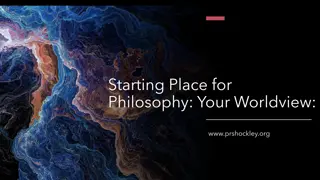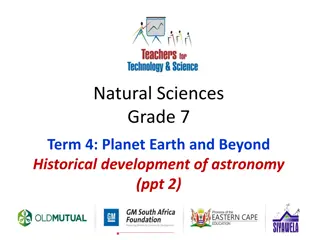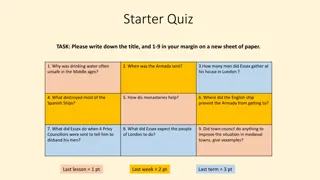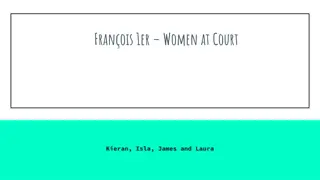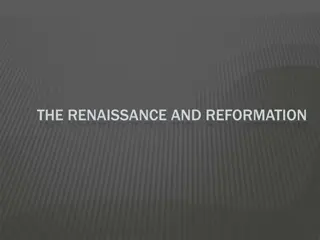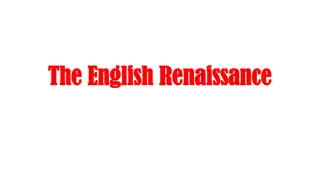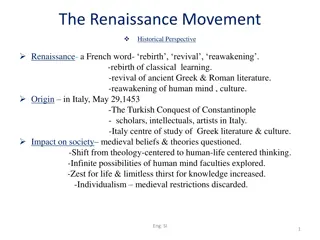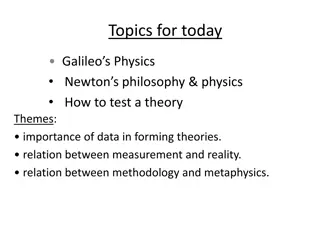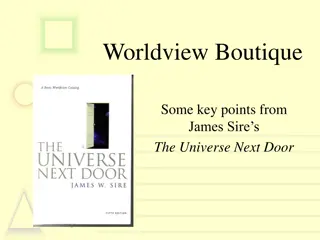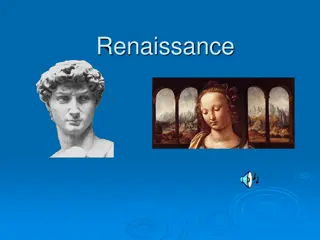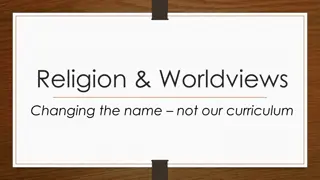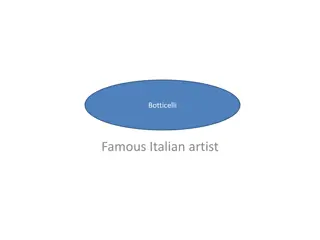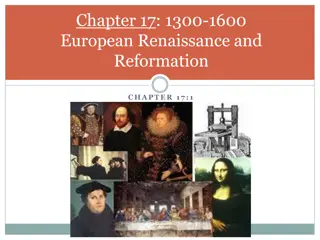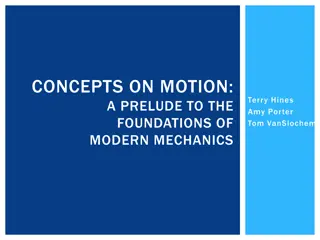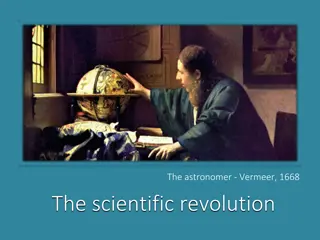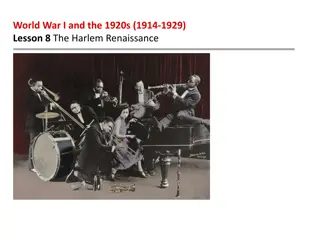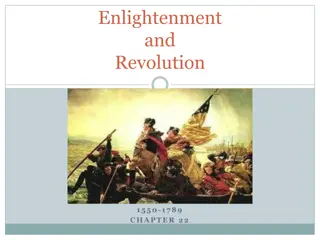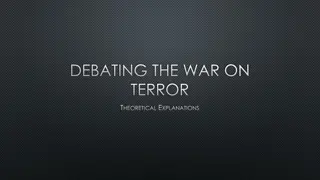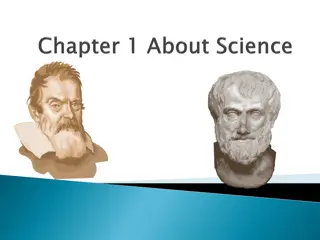Galileo Galilei and the Clash of Worldviews in the Renaissance Era
Galileo Galilei, born in 1564, navigated the turbulent waters of a Europe divided by cultural, religious, and political upheavals. The backdrop of the Counter-Reformation and the clash between geocentric and heliocentric astronomical theories shaped Galileo's scientific endeavors, challenging established beliefs and setting the stage for the emergence of modern science.
Download Presentation

Please find below an Image/Link to download the presentation.
The content on the website is provided AS IS for your information and personal use only. It may not be sold, licensed, or shared on other websites without obtaining consent from the author. Download presentation by click this link. If you encounter any issues during the download, it is possible that the publisher has removed the file from their server.
E N D
Presentation Transcript
Critical Reading Neutral to possibly critical The following passage discusses the scientific life of Galileo Galilei in reference to the political, religious, artistic, and scientific movements of the age. Will probably involve some controversy
Critical Reading Galileo Galilei was born in 1564 into a Europe wracked by cultural ferment and religious strife. The popes of the Roman Catholic Church, powerful in their roles as both religious and secular leaders, had proven vulnerable to the worldly and decadent spirit of the age, and their personal immorality brought the reputation of the papacy to historic lows. In 1517, Martin Luther, a former monk, attacked Catholicism for having become too worldly and politically corrupt and for obscuring the fundamentals of Christianity with pagan elements. His reforming zeal, which appealed to a notion of an original, purified Christianity, set in motion the Protestant Reformation and split European Christianity in two.
Critical Reading In response, Roman Catholicism steeled itself for battle and launched the Counter-Reformation, which emphasized orthodoxy and fidelity to the true Church. The Counter-Reformation reinvigorated the Church and, to some extent, eliminated its excesses. But the Counter-Reformation also contributed to the decline of the Italian Renaissance, a revival of arts and letters that sought to recover and rework the classical art and philosophy of ancient Greece and Rome. The popes had once been great patrons of Renaissance arts and sciences, but the Counter-Reformation put an end to the Church s liberal leniency in these areas. Further, the Church s new emphasis on religious orthodoxy would soon clash with the emerging scientific revolution. Galileo, with his study of astronomy, found himself at the center of this clash.
Critical Reading Conservative astronomers of Galileo s time, working without telescopes, ascribed without deviation to the ancient theory of geocentricity. This theory of astronomy held that the earth ( geo, as in geography or geology ) lay at the center of the solar system, orbited by both the sun and the other planets. Indeed, to the casual observer, it seemed common sense that since the sun rose in the morning and set at night, it must have circled around the earth. Ancient authorities like Aristotle and the Roman astronomer Ptolemy had championed this viewpoint, and the notion also coincided with the Catholic Church s view of the universe, which placed mankind, God s principal creation, at the center of the cosmos. Buttressed by common sense, the ancient philosophers, and the Church, the geocentric model of the universe seemed secure in its authority. The Ptolemaic theory, however, was not impervious to attack. In the 16th century, astronomers strained to make modern observations fit Ptolemy s geocentric model of the universe.
Critical Reading Increasingly complex mathematical systems were necessary to reconcile these new observations with Ptolemy s system of interlocking orbits. Nicholas Copernicus, a Polish astronomer, openly questioned the Ptolemaic system and proposed a heliocentric system in which the planets including earth orbited the sun ( helios ). This more mathematically satisfying way of arranging the solar system did not attract many supporters at first, since the available data did not yet support a wholesale abandonment of Ptolemy s system. By the end of the 16th century, however, astronomers like Johannes Kepler (1571 1630) had also begun to embrace Copernicus s theory.
Critical Reading Ultimately, Galileo s telescope struck a fatal blow to the Ptolemaic system. But, in a sense, the telescope was also nearly fatal to Galileo himself. The Catholic Church, desperately trying to hold the Protestant heresy at bay, could not accept a scientific assault on its own theories of the universe. The pressures of the age set in motion a historic confrontation between religion and science, one which would culminate in 1633 when the Church put Galileo on trial, forced him to recant his stated and published scientific beliefs, and put him under permanent house arrest.
Critical Reading Generating SAT questions based on the reading: 1. Begin with main idea questions or passage as a whole type questions: Example: Which of the following best states the main idea of the passage? Generating SAT questions based on the reading: 1. Build answer choices by STARTING with the actual answer. Come up with a ONE SENTENCE summary of the passage: A) Science is vulnerable to outside social forces.
Critical Reading Generating SAT questions based on the reading: 1. Begin with main idea questions or passage as a whole type questions: Example: Which of the following best states the main idea of the passage? Generating SAT questions based on the reading: 1.Now come up with a distracter- these are plausible yet not the best choice type of questions. Often, a question s level of difficulty is built on distracters. Come up with a ONE SENTENCE partial summary: But since the passage takes a long time to discuss Galileo s run-ins with the Roman Catholic Church, you might have been tempted by this choice. A careful reader will have skimmed the opening AND concluding paragraphs. A) Science always conflicts with religion.
Critical Reading Generating SAT questions based on the reading: You try! Come up with three other answer possibilities: Actual answer choices: (C) Ideally, scientific theories should reinforce religious doctrine. (D) Science operates in a vacuum. (E) Advanced technology is the only route to good scientific theories.
Critical Reading Generating SAT questions based on the reading: 2. Next, try an attitude or tone question Example: The author s tone in this passage can best be described as Generating SAT questions based on the reading: 1. Build answer choices by STARTING with the actual answer. Use the opening blurb and the connotative word choices in the passage to help you discern a tone word. First decide whether the author s tone is positive, neutral, or negative. A. Analytical
Critical Reading The passage describes an entire time period, covering the different sides, and while it discusses how the Counter-Reformation affected Galileo, it never condemns or praises either the reformation or Galileo. It seeks mainly to describe what happened. So, it s a pretty neutral passage. Use the following tone words to create answer choices by selecting one that is overly positive, one that is negative and one that is neutral but doesn t quite fit. 1. accusatory-charging of wrong doing 2. apathetic-indifferent due to lack of energy or concern 3. awe-solemn wonder 4. bitter-exhibiting strong animosity as a result of pain or grief 5. cynical-questions the basic sincerity and goodness of people 6. condescension; condescending-a feeling of superiority 7. callous-unfeeling, insensitive to feelings of others 8. contemplative-studying, thinking, reflecting on an issue 9. critical-finding fault 10. choleric-hot-tempered, easily angered 11. contemptuous-showing or feeling that something is worthless or lacks respect 12. caustic-intense use of sarcasm; stinging, biting 13. conventional-lacking spontaneity, originality, and individuality See your green half slip of paper for a more complete list. *Note these lists are not exhaustive, but a starting point. Feel free to use words from your vocab lists!
Critical Reading Generating SAT questions based on the reading: You try! Come up with four other answer possibilities: Actual answer choices: (B) disturbed (C) skeptical (D) dramatic (E) reverent
Critical Reading Generating SAT questions based on the reading: Next, let s try a details from the passage question. Example: Thus: he had a problem with (1) pagan elements (2) corruption and worldliness (3) political involvement of the pope and (4) questionable morals from the leadership Which of the following was not a reason for Martin Luther s attack on the Catholic Church (lines 4 6)? Paraphrase all reasons THEN create a closely related choice that is NOT stated. cultural ferment and religious strife. The popes of the Roman Catholic Church, powerful in their roles as both religious and secular leaders, had proven vulnerable to the worldly and decadent spirit of the age, and their personal immorality brought the reputation of the papacy to historic lows. Luther attacked the Church for having become too worldly and politically corrupt and for obscuring the fundamentals of Christianity with pagan elements.
Critical Reading Generating SAT questions based on the reading: a details from the passage question. Which of the following was not a reason for Martin Luther s attack on the Catholic Church (lines 4 6)? Actual answer choices: (A) pagan elements in its practices (B) the amorality of its leadership (C) its excessive attention to piety (D) its corruption and worldliness (E) the political involvement of the popes
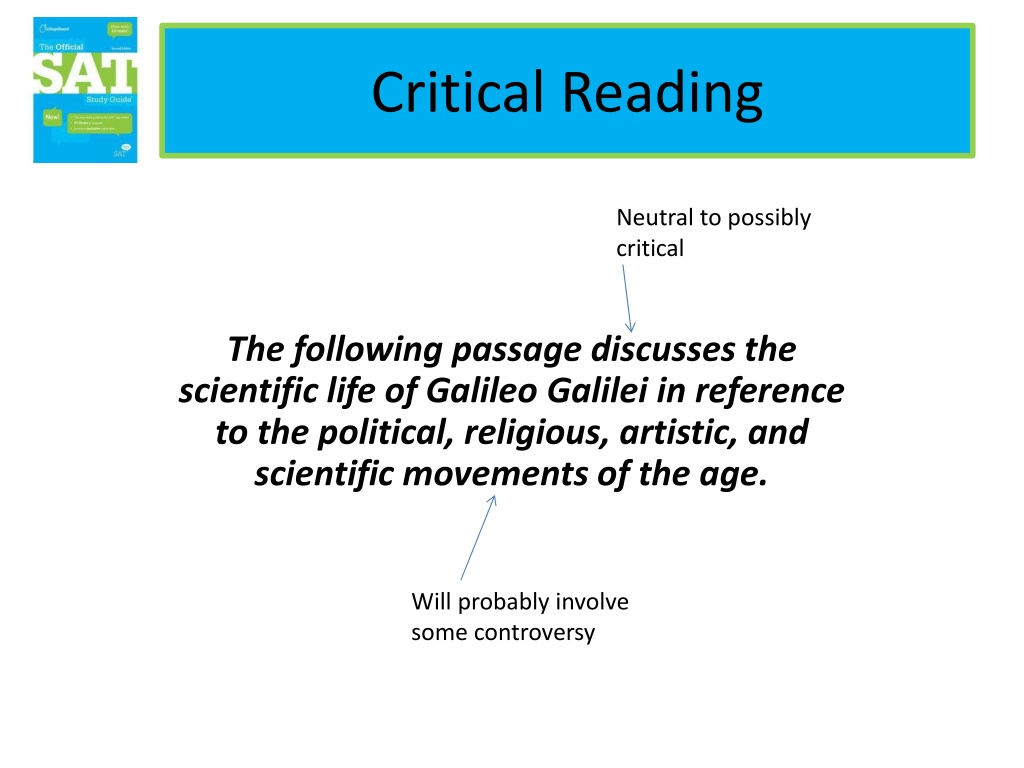


![Read⚡ebook✔[PDF] Io After Galileo: A New View of Jupiter's Volcanic Moon (Sprin](/thumb/21612/read-ebook-pdf-io-after-galileo-a-new-view-of-jupiter-s-volcanic-moon-sprin.jpg)
